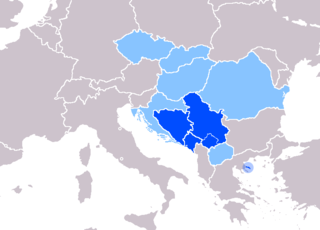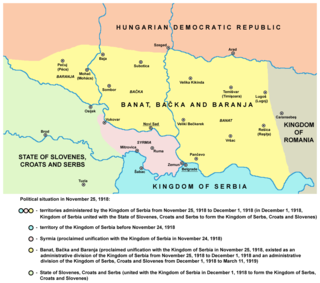| Batschka-Torontal District Bezirk Batschka-Torontal Бачко-торонталски округ Bačko-torontalski okrug Bács-Torontáli körzet Districtul Bacica-Torontal | |||||
| district of the Voivodeship of Serbia and Banat of Temeschwar | |||||
| |||||
 | |||||
| Capital | not specified | ||||
| History | |||||
| • | Established | 1849 | |||
| • | Disestablished | 1850 | |||
| Today part of | Serbia, Romania, Hungary, Croatia | ||||
Batschka-Torontal District (Serbian : Bačko-torontalski okrug or Бачко-торонталски округ; German : Bezirk Batschka-Torontal; Hungarian : Bács-Torontáli körzet; Romanian : Districtul Bacica-Torontal; Croatian : Bačko-torontalski okrug) was one of two original administrative districts of the Voivodeship of Serbia and Banat of Temeschwar (a crown land within Austrian Empire). It existed from 1849 to 1850.

Serbian is the standardized variety of the Serbo-Croatian language mainly used by Serbs. It is the official language of Serbia, the territory of Kosovo, and one of the three official languages of Bosnia and Herzegovina. In addition, it is a recognized minority language in Montenegro where it is spoken by the relative majority of the population, as well as in Croatia, North Macedonia, Romania, Hungary, Slovakia, and the Czech Republic.

German is a West Germanic language that is mainly spoken in Central Europe. It is the most widely spoken and official or co-official language in Germany, Austria, Switzerland, South Tyrol (Italy), the German-speaking Community of Belgium, and Liechtenstein. It is also one of the three official languages of Luxembourg and a co-official language in the Opole Voivodeship in Poland. The languages which are most similar to German are the other members of the West Germanic language branch: Afrikaans, Dutch, English, the Frisian languages, Low German/Low Saxon, Luxembourgish, and Yiddish. There are also strong similarities in vocabulary with Danish, Norwegian and Swedish, although those belong to the North Germanic group. German is the second most widely spoken Germanic language, after English.

Hungarian is a Finno-Ugric language spoken in Hungary and several neighbouring countries. It is the official language of Hungary and one of the 24 official languages of the European Union. Outside Hungary it is also spoken by communities of Hungarians in the countries that today make up Slovakia, western Ukraine (Subcarpathia), central and western Romania (Transylvania), northern Serbia (Vojvodina), northern Croatia, and northern Slovenia. It is also spoken by Hungarian diaspora communities worldwide, especially in North America and in Israel. Like Finnish and Estonian, Hungarian belongs to the Uralic language family. With 13 million speakers, it is its largest member in terms of speakers.

















